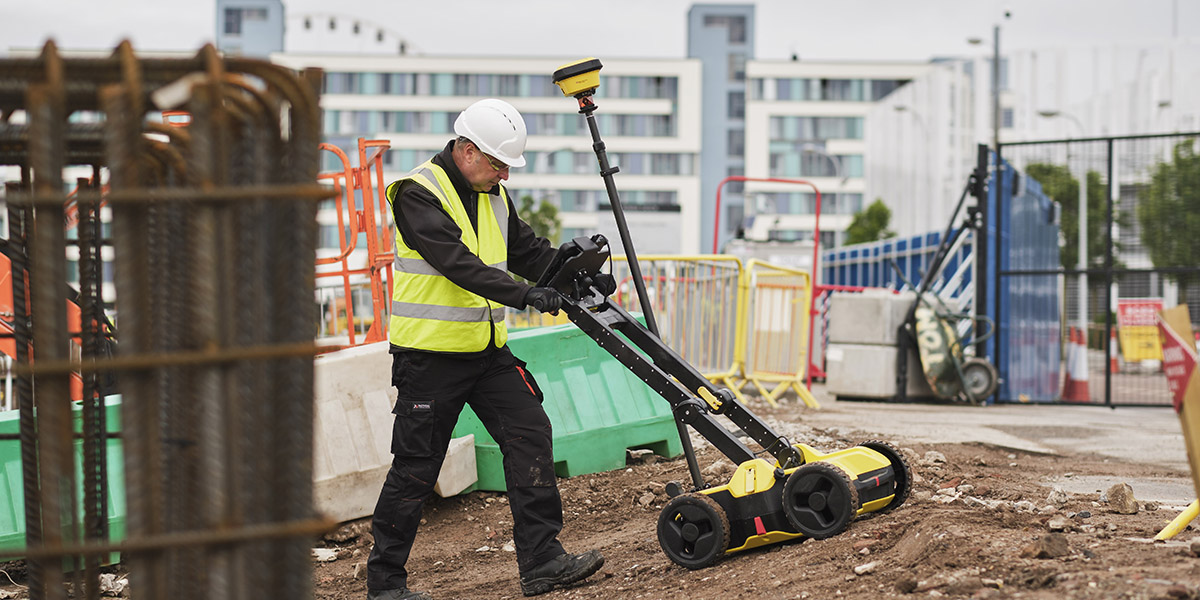Ground Penetrating Radar
Ground-penetrating radar is a method which uses radar pulses to create an image of the subsurface. Electromagnetic radiation which is non-destructive is used to detect reflected signals from structures within the subsurface. Ground-penetrating radar (GPR) can be used in a range of different mediums such as soil, rock, structures and pavements.
We provide two different GPR systems, the RD1000+ from RadioDetection and the new Opera Duo. Both are very robust, easy to use and highly recommended for the detection of underground utilities where electromagnetic surveys are not possible. They can be used with electromagnetic surveys to identify utilities and services below the surface. This can also be used with GPS and TPS to give high accuracy, drawings and to adhere to the PAS128 specification.
If you would like more information or a demonstration please contact us.
What is Ground Penetrating Radar?
Fun fact, ground penetrating radar was created in the 1930s as a method for measuring and monitoring the thickness of glaciers.
Ground penetrating radar, often referred to as GPR is a non-destructive detection and imaging method used when surveying sub-surface areas to establish the location of underground utilities, such as metal, pipes, cables and even concrete.
A GPR survey is commonly used for excavations, prior to breaking ground. This locating tool emits GPR radar pulses into the ground, these pulses are then reflected off subsurface objects. Variations in the signals are recorded by a receiving antenna which uses these signals to build a map of the subsurface utilities and obstructions below.


What does GPR Survey Equipment Detect?
There are many things GPR equipment can detect, including cement, archaeological features, ground layers (such as soil), sand and rock as well as utility lines, pipes, erosion, voids, cracks and underground structures such as tunnels or caves.
What does Ground Penetrating Radar Not Detect?
There are some limitations to the wonders of GPR, for example, GPR surveys are not effective at detecting non-metallic utilities such as fibre optic cables and plastic piping. It is also worth noting that GPR signals can be obstructed by electromagnetic interference as well as variations in materials within the subsurface.
Who should use utility detection solutions?
Contractors, site project managers and surveyors who need to locate, map and or avoid subsurface utilities in a safe, efficient and reliable manner. This solution is particularly useful for those working on civil engineering, infrastructure, building and maintenance projects.
View all utility detection tools here.
5 Advantages of Ground Penetrating Radar for Utility Locating
- Real-time data:
The ability to capture data in real-time means surveyors can quickly interpret results and make informed decisions on-site, vastly increasing project efficiency. - Versatility: A ground penetrating radar survey can pick up a wide range of utilities reducing the need to use multiple tools. It is also applicable to a wide variety of uses such as collecting geotechnical data, environmental uses such as water-table mapping and within the transportation industry for uses such as bridge condition assessments.
- Non-destructive: A GPR survey uses electromagnetic radiation to map out underground utilities. This approach enables surveyors to avoid damaging surrounding structures and the site.
- High accuracy: While it’s difficult to say exactly how accurate GPR signals are it is assumed accuracy is around 90%, enabling high-resolution image creation of the subsurface.
- Safety: A ground radar survey greatly reduces the risk of an accidental utility strike, vastly increasing the safety of operators whilst also protecting the project timeline and budget.
How to Choose GPR Survey Equipment Tools
It can be tricky to decide which GPR survey tool is right for you and your team, that’s why we’re here to help. SCCS offer a range of options from free product demonstrations that let you get your hands on the equipment to hir and second-hand purchase options.
Hire GPR Survey Equipment
In addition to selling GPR solutions, we also offer a range of high-quality GPR survey equipment on a rental basis for those who only need the equipment on an ad-hoc basis.
The advantage of renting your survey equipment is that you will always have access to the latest technology as well as full technical support from the SCCS team. In addition, you don’t need to suffer the depreciation of the equipment value when you don’t need to use it. Renting survey equipment is also a great way to try out a variety of solutions before deciding to buy.
Explore hire options.
Try before buying with demonstrations
If you know you would like to buy equipment but are not sure what is right for you then it might be best to try before you buy. We offer free demonstrations so you can ensure you get the right survey equipment for your needs, with specialist advice and support from SCCS technicians.
Book a demonstration.
Buy used GPR Survey Equipment
Our team at SCCS have a wide range of used ground penetrating radar survey equipment that has been serviced, certified and stamped with a six-month guarantee. So if you’re looking for equipment on a budget this could be a great option.
Enquire about used survey equipment.
Buy Ground Penetrating Radar Equipment
We offer a wide range of ground penetration radar solutions such as the Leica DS2000 Utility Detection Radar, Leica DSX and Stream D. For the best results we recommend speaking with a member of the team for bespoke advice.
View the full GPR range here.
Contact the team